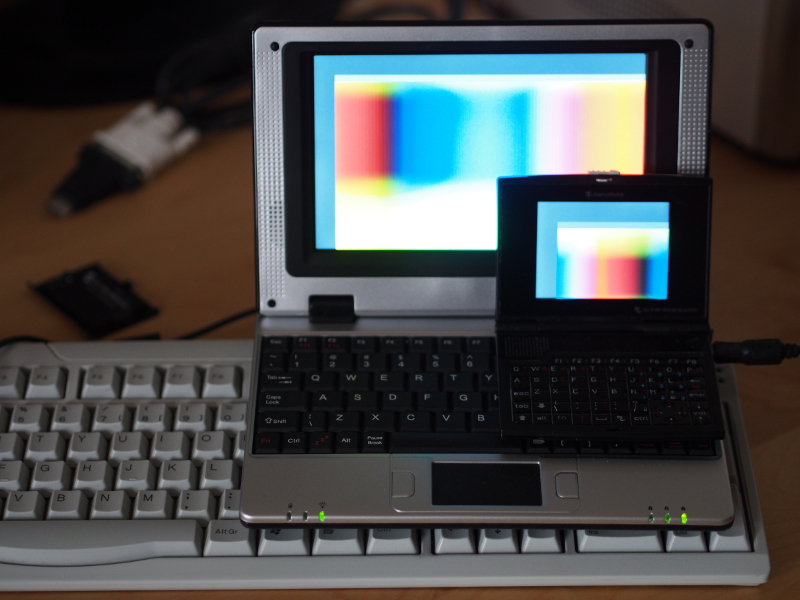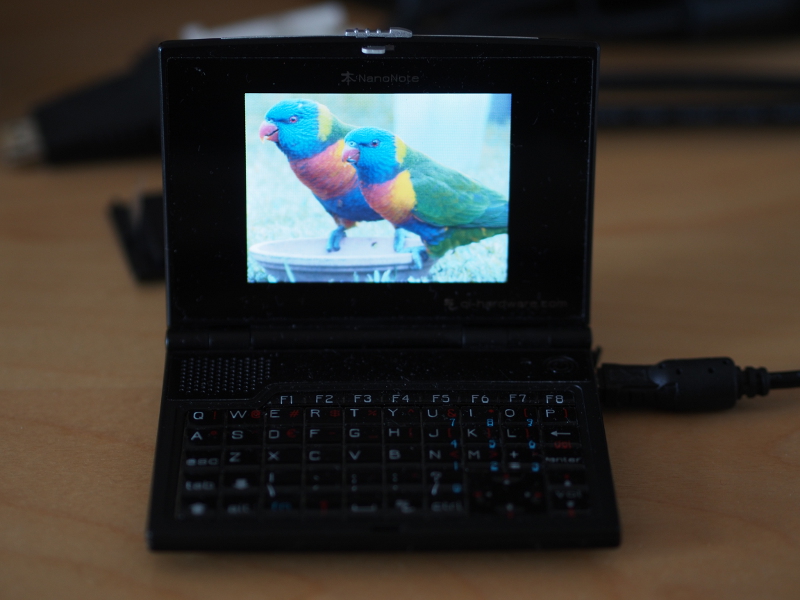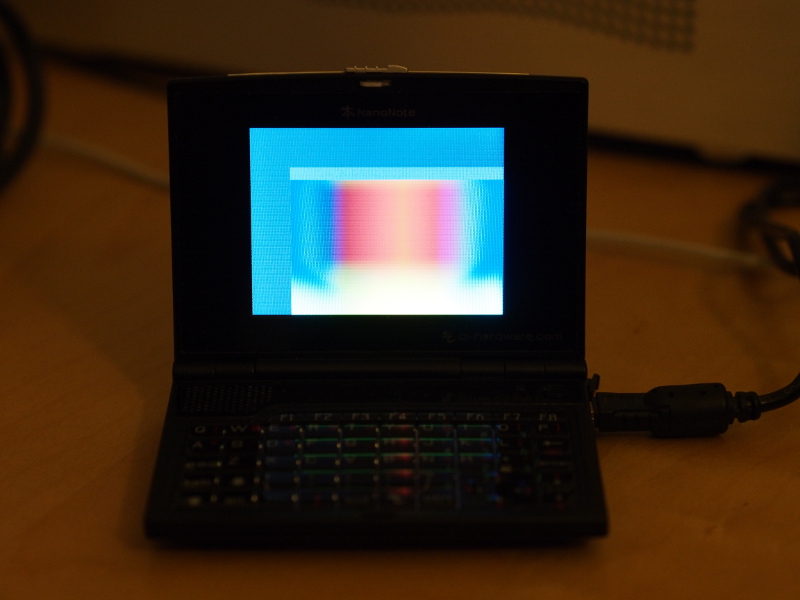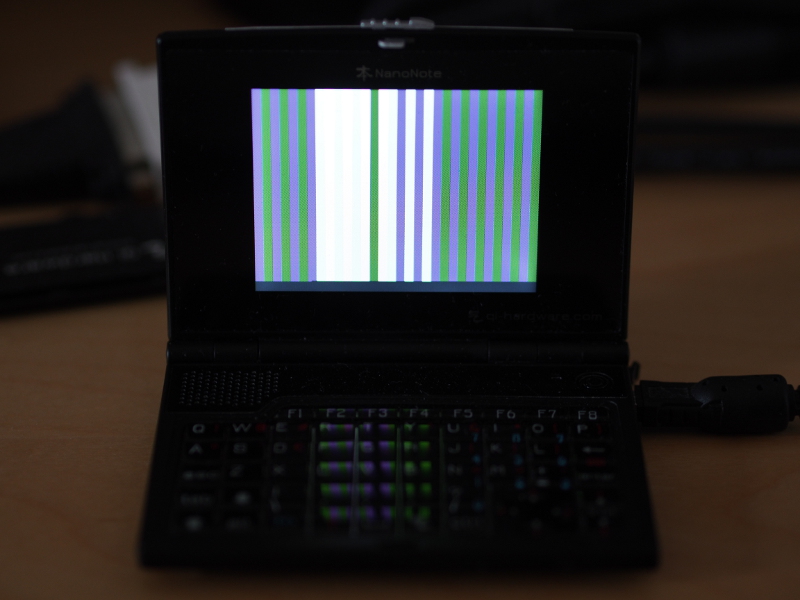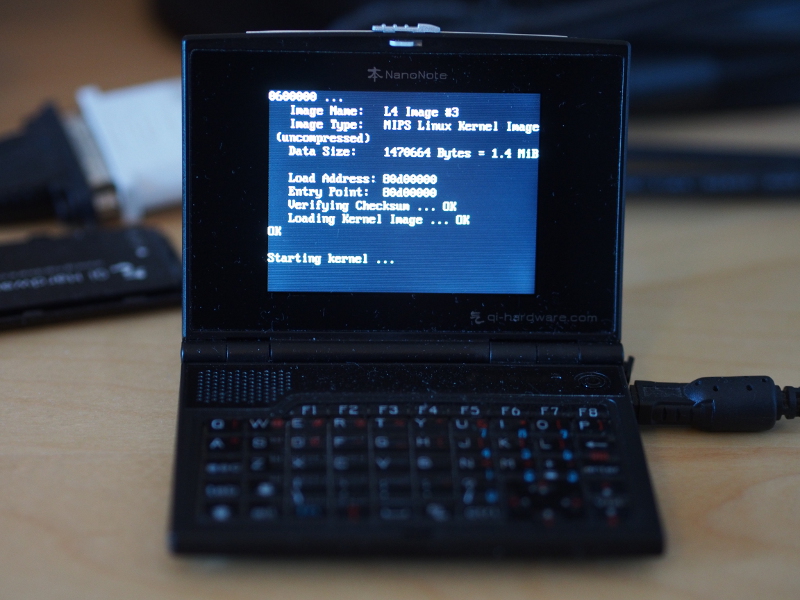With some confidence that the effort put in previously had resulted in a working Fiasco.OC kernel, I now found myself where I had expected to be at the start of this adventure: in the position of trying to get an example program working that could take advantage of the framebuffer on the Ben NanoNote. In fact, there is already an example program called “spectrum” that I had managed to get working with the UX variant of Fiasco.OC (this being a kind of “User Mode Fiasco” which runs as a normal process, or maybe a few processes, on top of a normal GNU/Linux system).
However, if this exercise had taught me nothing else, it had taught me not to try out huge chunks of untested functionality and then expect everything to work. It would instead be a far better idea to incrementally add small chunks of functionality whose correctness (or incorrectness) would be easier to see. Thus, I decided to start with a minimal example, adding pieces of tested functionality from my CI20 experiments that obtain access to various memory regions. In the first instance, I wanted to see if I could exercise control over the LCD panel via the general-purpose input/output (GPIO) memory region.
Wiring Up
At this point, I should make a brief detour into the matter of making peripherals available to programs. Unlike the debugging code employed previously, it isn’t possible to just access some interesting part of memory by taking an address and reading from it or writing to it. Not only are user space programs working with virtual memory, whose addresses need not correspond to the actual physical locations employed by the underlying hardware, but as a matter of protecting the system against program misbehaviour, access to memory regions is strictly controlled.
In L4Re, a component called Io is responsible for granting access to predefined memory regions that describe hardware peripherals or devices. My example needed to have the following resources defined:
- A configuration description (placed in l4/conf/examples/mips-qi_lb60-lcd.cfg)
- The Io peripheral bus description (placed in l4/conf/examples/mips-qi_lb60-lcd.io)
- A list of modules needing deployment (added as an entry to l4/conf/modules.list, described separately in l4/conf/examples/mips-qi_lb60-lcd.list)
It is perhaps clearer to start with the Io-related resource, which is short enough to reproduce here:
local hw = Io.system_bus()
local bus = Io.Vi.System_bus
{
CPM = wrap(hw:match("jz4740-cpm"));
GPIO = wrap(hw:match("jz4740-gpio"));
LCD = wrap(hw:match("jz4740-lcd"));
}
Io.add_vbus("devices", bus)
This is Lua source code, with Lua having been adopted as a scripting language in L4Re. Here, the important things are those appearing within the hw:match function call brackets: each of these values refers to a device defined in the Ben’s hardware description (found in l4/pkg/io/io/config/plat-qi_lb60/hw_devices.io), identified using the “hid” property. The “jz4740-gpio” value is used to locate the GPIO device or peripheral, for instance.
Also important is the name used for the bus, “devices”, in the add_vbus function call at the bottom, as we shall see in a moment. Moving on from this, the configuration description for the example itself contains the following slightly-edited details:
local io_buses =
{
devices = l:new_channel();
};
l:start({
caps = {
devices = io_buses.devices:svr(),
icu = L4.Env.icu,
sigma0 = L4.cast(L4.Proto.Factory, L4.Env.sigma0):create(L4.Proto.Sigma0),
},
},
"rom/io -vvvv rom/hw_devices.io rom/mips-qi_lb60-lcd.io");
l:start({
caps = {
icu = L4.Env.icu,
vbus = io_buses.devices,
},
},
"rom/ex_qi_lb60_lcd");
Here, the “devices” name seemingly needs to be consistent with the name used in the caps mapping for the Io server, set up in the first l:start invocation. The name used for the io_buses mapping can be something else, but then the references to io_buses.devices must obviously be changed to follow suit. I am sure you get the idea.
The consequence of this wiring up is that the example program, set up at the end, accesses peripherals using the vbus capability or channel, communicating with Io and requesting access to devices, whose memory regions are described in the Ben’s hardware description. Io acts as the server on this channel whereas the example program acts as the client.
Is This Thing On?
There were a few good reasons for trying GPIO access first. The most significant one is related to the framebuffer. As you may recall, as the kernel finished starting up, sigma0 started, and we could then no longer be sure that the framebuffer configuration initialised by the bootloader had been preserved. So, I could no longer rely on any shortcuts in getting information onto the screen.
Another reason for trying GPIO operations was that I had written code for the CI20 that accessed input and output pins, and I had some confidence in the GPIO driver code that I had included in the L4Re package hierarchy actually working as intended. Indeed, when working with the CI20, I had implemented some driver code for both the GPIO and CPM (clock/power management) functionality as provided by the CI20’s SoC, the JZ4780. As part of my preparation for this effort, I had adapted this code for the Ben’s SoC, the JZ4720. It was arguably worthwhile to give this code some exercise.
One drawback with using general-purpose input/output, however, is that the Ben doesn’t really have any conveniently-accessed output pins or indicators, whereas the CI20 is a development board with lots of connectors and some LEDs that can be used to give simple feedback on what a program might be doing. Manipulating the LCD panel, in contrast, offers a very awkward way of communicating program status.
Experiments proved somewhat successful, however. Obtaining access to device memory was as straightforward as it had been in my CI20 examples, providing me with a virtual address corresponding to the GPIO memory region. Inserting some driver code employing GPIO operations directly into the principal source file for the example, in order to keep things particularly simple and avoid linking problems, I was able to tell the panel to switch itself off. This involves bit-banging SPI commands using a number of output pins. The consequence of doing this is that the screen fades to white.
I gradually gained confidence and decided to reserve memory for the framebuffer and descriptors. Instead of attempting to use the LCD driver code that I had prepared, I attempted to set up the descriptors manually by writing values to the structure that I knew would be compatible with the state of the peripheral as it had been configured previously. But once again, I found myself making no progress. No image would appear on screen, and I started to wonder whether I needed to do more work to reinitialise the framebuffer or maybe even the panel itself.
But the screen was at least switched on, indicating that the Ben had not completely hung and might still be doing something. One odd thing was that the screen would often turn a certain colour. Indeed, it was turning purple fairly consistently when I realised my mistake: my program was terminating! And this was, of course, as intended. The program would start, access memory, set up the framebuffer, fill it with a pattern, and then finish. I suspected something was happening and when I started to think about it, I had noticed a transient bit pattern before the screen went blank, but I suppose I had put this down to some kind of ghosting or memory effect, at least instinctively.
When a program terminates, it is most likely that the memory it used gets erased so as to prevent other programs from inheriting data that they should not see. And naturally, this will result in the framebuffer being cleared, maybe even the descriptors getting trashed again. So the trivial solution to my problem was to just stop my program from terminating:
while (1);
That did the trick!
The Build-Up
Accessing the LCD peripheral directly from my example is all very well, but I had always intended to provide a display driver for the Ben within L4Re. Attempting to compile the driver as part of the general build process had already identified some errors that had been present in what effectively had been untested code, migrated from my earlier work and modified for the L4Re APIs. But I wasn’t about to try and get the driver to work in one go!
Instead, I copied more functionality into my example program, giving things like the clock management functionality some exercise, using my newly-enabled framebuffer output to test the results from various enquiries about clock frequencies, also setting various frequencies and seeing if this stopped the program from working. This did lead me on another needlessly-distracting diversion, however. When looking at the clock configuration values, something seemed wrong: they were shifted one bit to the left and therefore provided values twice as large as they should have been.
I emitted some other values and saw that they too were shifted to the left. For a while, I wondered whether the panel configuration was wrong and started adjusting all sorts of timing-related values (front and back porches, sync pulses, video-related things), reading up about how the panel was configured using the SPI communications described above. It occurred to me that I should investigate how the display output was shifted or wrapped, and I used the value 0x80000001 to put bit values at the extreme left and right of the screen. Something was causing the output to be wrapped, apparently displaced by 9 pixels or 36 bytes to the left.
You can probably guess where this is heading! The panel configuration had not changed and there was no reason to believe that it was wrong. Similarly, the framebuffer was being set up correctly and was not somehow moved slightly in memory, not that there is really any mechanism in L4Re or the hardware that would cause such a bizarre displacement. I looked again at my debugging code and saw my mistake; in concise terms, it took this form:
for (i = 0; i < fb_size / 4; i++)
{
fb[i] = value & mask ? onpix : offpix; // write a pixel
if ((i % 10) == 0) // move to the next bit?
...
}
For some reason, I had taken some perfectly acceptable code and changed one aspect of it. Here is what it had looked like on the many occasions I had used it in the past:
i = 0;
while (i < fb_size / 4)
{
fb[i] = value & mask ? onpix : offpix; // write a pixel
i++;
if ((i % 10) == 0) // move to the next bit?
...
}
That’s right: I had accidentally reordered the increment and “next bit” tests, causing the first bit in the value to occupy only one pixel, prematurely skipping to the next bit; at the end of the value, the mask would wrap around and show the remaining nine pixels of the first bit. Again, I was debugging the debugging and wasting my own time!
But despite such distractions, over time, it became interesting to copy the complete source file that does most of the work configuring the hardware from my driver into the example directory and to use its functions directly, these functions normally being accessed by more general driver code. In effect, I was replicating the driver within an environment that was being incrementally enhanced, up until the point where I might assume that the driver itself could work.
With no obvious problems having occurred, I then created another example without all the memory lookup operations, copied-in functions, and other “instrumentation”: one that merely called the driver API, relying on the general mechanisms to find and activate the hardware…
struct arm_lcd_ops *ops = arm_lcd_probe("nanonote");
…obtaining a framebuffer address and size…
fb_vaddr = ops->get_fb();
fb_size = ops->get_video_mem_size();
…and then writing data to the screen just as I had done before. Indeed, this worked just like the previous example, indicating that I had managed to implement the driver’s side of the mechanisms correctly. I had a working LCD driver!
Adopting Abstractions
If the final objective had been to just get Fiasco.OC running and to have a program accessing the framebuffer, then this would probably be the end of this adventure. But, in fact, my aim is to demonstrate that the Ben NanoNote can take advantage of the various advertised capabilities of L4Re and Fiasco.OC. This means supporting facilities like the framebuffer driver, GUI multiplexer, and potentially other things. And such facilities are precisely those demonstrated by the “spectrum” example which I had promised myself (and my readership) that I would get working.
At this point, I shouldn’t need to write any more of my own code: the framebuffer driver, GUI multiplexer, and “spectrum” example are all existing pieces of L4Re code. But what I did need to figure out was whether my recipe for wiring these things up was still correct and functional, and whether my porting exercise had preserved the functionality of these things or mysteriously broken them!

